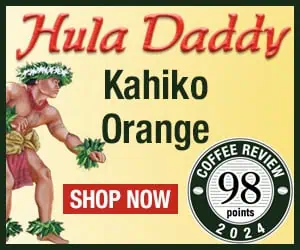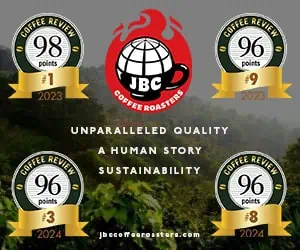The coffees that sell best in the American specialty marketplace often are not the same coffees that American specialty coffee professionals (and reviewers) would like to see sell the best. It occurred to me to ask a selection of regional roasters for the coffees their customers prefer, as opposed to the coffees they prefer as professionals.
Coffee Review staff members approached six roaster-retailers, all with clear regional identities. Four of the six roasters submitted two coffees each, a wholesale best-seller and a retail best-seller. Presumably the wholesale best-sellers reflect the preferences of coffee drinkers as filtered through café and restaurant owners and managers, whereas the retail best-sellers directly reflect the tastes of the customers who purchase their coffees over the counters of the roasting firms’ retail stores.
In the case of Intelligentsia, a roaster in Chicago, the retail and wholesale best seller was the same, an interesting coffee called Black Cat Blend. And Christian Waskiewicz, roastmaster at Alpen Sierra in Lake Tahoe, California, cheated a little by sending what he considered his best coffee along with his company’s best-selling coffee.
So we have ten coffees, more or less split between wholesale and retail best-sellers, plus one professionally-chosen ringer.
So what great and useful truths are revealed by these eleven coffees? Not as much as I hoped, to tell the truth. As they say in the social sciences, the sample was too small. We’re only one step up from anecdotal evidence here.
Nevertheless, speculatively and anecdotally speaking, here are a couple of observations:
It would appear that American specialty coffee drinkers prefer profiles that are sweeter and rounder than the bigger, more acidy profiles that coffee professionals often prefer.
The one professional’s choice coffee, the Alpen Sierra Kenya Nyaithee AA, was, to my taste, significantly better than any of the ten best-sellers. Either: 1) the American coffee-drinking public is still not up to a coffee as dramatically complex and distinctive and this Kenya; or 2) The American coffee-drinking public is still not up to paying a couple extra bucks more for a coffee as dramatically complex and distinctive as this Kenya; or 3) Coffee roasters and coffee reviewers tend to like the same kinds of dramatically complex and distinctive coffees.
Ringer issue aside, there were some very impressive coffees among the best-sellers. The roasting was uniformly skillful and the blend concepts interesting and original. From the points of view the customers who voted for these coffees with their wallets are getting their money’s worth and more.
On the other hand, three of the eleven coffees strongly hinted at taste defects in some of the several cups of each I tasted. These were the kind of defects produced by faults in processing, drying or storing the green coffees, not in the roasting. Two of the hinting-at-defective coffees were blends. I only hope that the pressures of producing a distinctive-tasting blend at a reasonable best-selling price didn’t lead roasters to risk slipping some cheaper, marginal coffees into these otherwise appealing blends.










